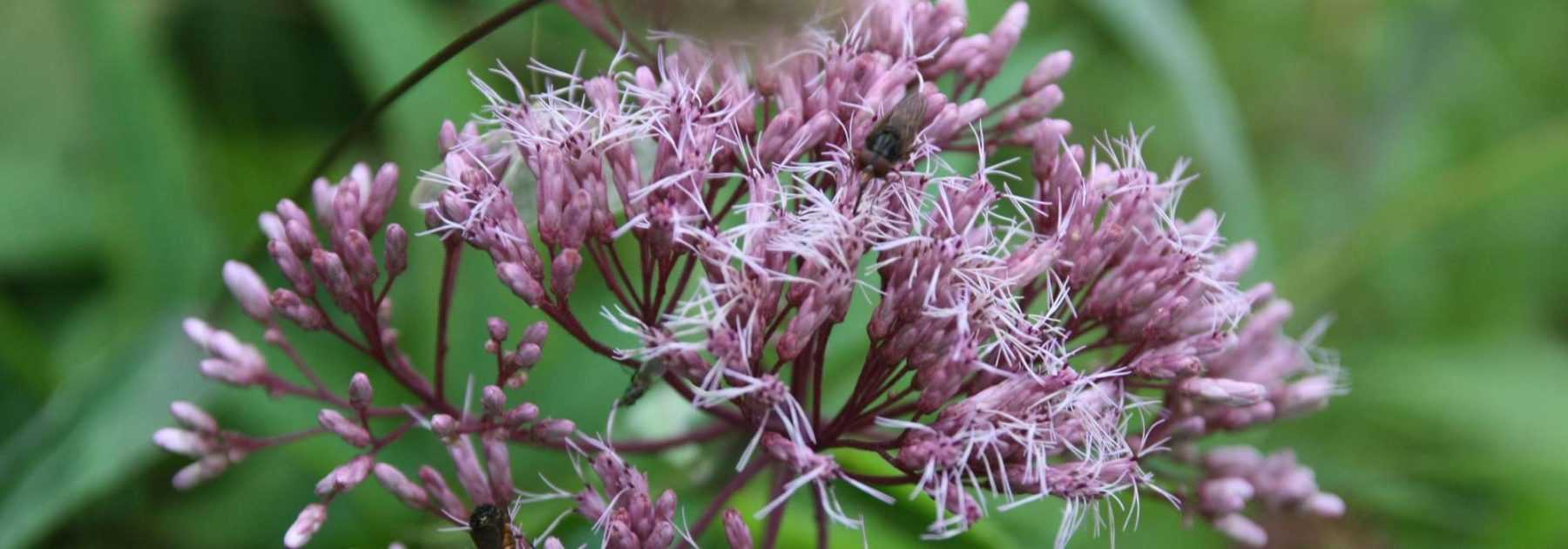
Eupatorium: Planting, Growing and Care
Contents
The Joe-Pye weed in a few words
- Eupatorium is a tall perennial with elegant summer flowering.
- Its airy corymb flowers come in pink, purple or white.
- It thrives in rich, moist, even wet soils.
- Highly nectar-rich, its flowers attract numerous butterflies and pollinating insects.
- Ideal for pond edges or water features, but also works well in flower beds.
Our expert's word
The boneset is a striking tall perennial, notable for its elegant summer bloom of pink, purple or white flower clusters. This delicate, airy flowering, with its more or less fuzzy appearance, stands out against deep green foliage, made even more vibrant by the contrast with the intense purple of its sturdy upright stems. The genus also includes a sublime variety with chocolate-coloured foliage: Eupatorium rugosum ‘Chocolate’.
The bushy habit of bonesets, reaching up to 2m tall for the giant E. maculatum ‘Atropurpureum’, sometimes leads them to be mistaken for shrubs. Its rapid growth combined with this upright habit makes it an ideal candidate for the back of borders, where it can showcase spring or summer-flowering plants.
This perennial, native to the wetlands of North America and Europe, thrives in rich, moist, even heavy soils, where it grows vigorously. Undemanding, it can adapt to any ordinary soil, as long as it remains moist. In dry soil, the plant’s foliage takes on an unsightly scorched appearance and struggles to flower.


Boneset flowers come in various shades: Eupatorium rugosum ‘Chocolate’, Eupatorium maculatum ‘Atropurpureum’, Eupatorium coelestinum, Eupatorium cannabinum ‘Plenum’, Eupatorium ‘Lucky Melody’.
However, its need for moisture is its only weakness, as boneset is truly hardy and resistant to everything! It fears neither diseases nor pests and boasts excellent hardiness (down to -15°C), allowing it to thrive in all regions. Deciduous, it reappears with full vigour each spring, requiring no effort beyond a winter cutback.
This easy-to-grow plant, even for beginner gardeners, self-seeds freely to form increasingly dense clumps. A spreading nature to fully exploit in natural gardens, where its nectar-rich flowers attract numerous butterflies. An added bonus that will also appeal to urban gardens in need of rustic charm!
Description and botany
Botanical data
- Latin name Eupatorium
- Family Astéracées
- Common name Eupatoire
- Flowering Estivale
- Height 0,60 à 2 m
- Exposure soleil ou mi-ombre
- Soil type humide
- Hardiness jusqu’à -15°C
The Eupatorium genus belongs to the large Asteraceae family. These tall perennials are all native to North America, with the exception of Eupatorium cannabinum, which is European.
Boneset is a hardy perennial with a bushy habit, naturally thriving in cool, even moist environments. It flourishes spontaneously in marshy meadows, ditches or woodland areas, and works wonders in our gardens when planted near a pond.
Its upright stems, often purple in colour, bear deciduous foliage in varying shades of green, turning yellow or brown in Eupatorium coelestinum and Eupatorium rugosum ‘Braunlaub’. The variety Eupatorium rugosum ‘Chocolate’ offers a delightful chocolate hue during summer before turning green when flowering begins.
Boneset foliage is typically finely lance-shaped and slightly toothed, though this spear-like form is more spread out in Eupatorium coelestinum or rugosum. The perfoliate boneset is particularly striking with its pairs of opposite, stem-piercing leaves lacking petioles. The European species stands out as an original, with E. cannabinum displaying divided leaves resembling those of Indian hemp, giving it a slightly wilder appearance than other species.
Boneset flowers appear as elegant corymbs in pink, white or purple, with a light and airy appearance. Blooming begins in July, though sometimes later, but compensates with rapid, vigorous growth ensuring spectacular flowering until late summer and sometimes into October, depending on the species.
Highly nectar-rich, Eupatorium flowers attract numerous butterflies and pollinating insects, making them valuable allies near vegetable plots. This hardy perennial also works wonders in borders or large beds, either alone or combined with other moisture-loving plants. Tall species like the purple boneset, reaching 2m, are perfect for background planting. At 80cm tall, Eupatorium coelestinum is better suited to border planting in natural gardens.
Easy-going, boneset thrives in all regions provided the soil remains moist, even during the driest summers. Beyond this essential requirement for good flowering, this perennial needs no maintenance and even self-seeds. Once dried in late autumn, simply cut it back and await its return next spring!


Different boneset foliage: Eupatorium perfoliatum, Eupatorium rugosum ‘Chocolate’, Eupatorium cannabinum ‘Plenum’, Eupatorium rugosum, Eupatorium maculatum ‘Atropurpureum’.
Species and varieties
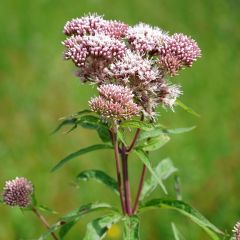
Eupatorium cannabinum Plenum
- Blütezeit September to November
- Höhe bei Reife 1,50 m
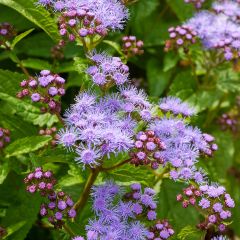
Eupatorium coelestinum
- Blütezeit August to November
- Höhe bei Reife 80 cm
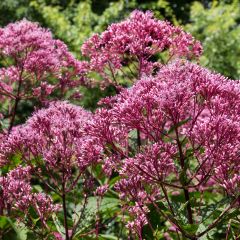
Eupatorium maculatum Atropurpureum
- Blütezeit September, October
- Höhe bei Reife 2 m
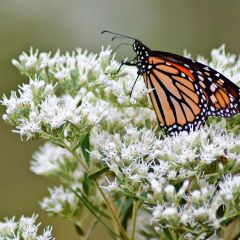
Eupatorium perfoliatum
- Blütezeit September to November
- Höhe bei Reife 1,10 m
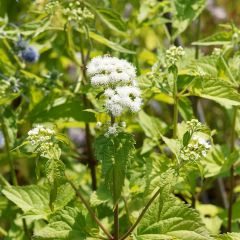
Eupatorium rugosum Braunlaub
- Blütezeit September, October
- Höhe bei Reife 1 m
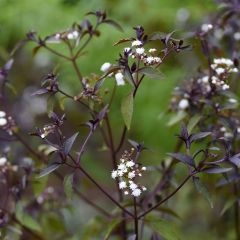
Eupatorium rugosum Chocolate
- Blütezeit October, November
- Höhe bei Reife 1,20 m
Planting Eupatorium
Where to plant it?
Eupatorium is a very hardy (down to -15°C) perennial that adapts to all climates, with one condition: it needs moist, even wet soil that never dries out. In dry soil, it wilts quickly and its foliage takes on a scorched appearance. Although it prefers heavy, clay soils, it can thrive in any ordinary, moist and well-drained soil.
Apart from this requirement, eupatorium is not fussy. It doesn’t matter what the soil pH is or how polluted the air is—it settles easily in any garden. In urban areas, it’s particularly perfect for adding a wild touch and promoting biodiversity. Eupatorium is indeed very nectar-rich and will certainly attract pollinating insects, especially butterflies.
For vibrant colours and beautiful flowering, choose a sunny spot if possible. However, eupatorium is naturally found at forest edges, so it doesn’t mind partial shade.
We don’t recommend growing it in pots, as this doesn’t do justice to its bushy habit and slightly wild look. Instead, eupatorium works wonderfully in borders, as a backdrop or for adding height, as well as in wildflower meadows, flower beds, or even as a standalone feature. Its preference for moist soils also makes it an ideal candidate for pond or stream edges.
When to plant eupatorium?
Eupatorium is best planted between February and April. Be cautious if you live in a mountainous climate, as young shoots may be vulnerable to late frosts. It can also be planted in autumn, between September and November, particularly in warmer climates like Mediterranean regions.
How to plant it?
- Prepare the soil by loosening it deeply with a garden fork.
- Enrich the soil by mixing in well-rotted compost.
- Dig a hole 3 times the size of the root ball.
- Place the plant, ensuring the crown (where roots meet stems) is level with the soil surface.
- Firm the soil and water thoroughly.
We recommend planting 3 to 5 plants per square metre to ensure a lush, bushy effect.
Maintenance
When grown in fresh, rich and clayey soil, the boneset requires no maintenance. In ordinary soil, a small addition of compost in early spring will encourage its regrowth.
Be aware that in dry soil, the boneset develops poorly and wilts quickly. Water regularly to maintain constant moisture at the base of your plants. Mulch to limit water evaporation and thus reduce watering. An excellent way to recycle your grass clippings, for example!
In any case, cut back the dried clump in late autumn to early winter. This operation helps maintain a compact shape the following spring. Cut each plant back to 10 cm from the ground when it is no longer decorative, between November and January. No need to mulch, it withstands cold temperatures down to -15°C.
Boneset is known for self-seeding very easily. A trait you can take advantage of in a wildflower meadow, but which may be problematic in flower beds. Nothing alarming though, as young plants are easily pulled out, making it simple to remove them if they become too numerous. You can also prevent self-seeding by removing faded flowers as they appear. This will also stimulate the emergence of new blooms.
In spring, watch out for slugs, which are fond of tender young shoots. If you face a gastropod invasion, treat with an organic slug control product, such as Ferramol. Otherwise, this perennial proves resistant to both diseases and pests.
Propagation: Sowing and Division
Boneset can be easily propagated by sowing or division.
Sowing Boneset Seeds
Boneset self-seeds naturally. If you wish to transplant the young seedlings, wait until they are sufficiently developed, in September-October.
You can also collect the seeds once the flowers have dried thoroughly. Store them in a dry, dark place and sow them in spring, between March and May, once the risk of frost has passed:
- Sow thinly in a seed tray using a “seed compost”.
- Place the tray in a cold frame until the seedlings reach about ten centimetres in height.
- Then transplant into individual pots.
Planting out in the ground is done in autumn, or the following spring in climates with harsh winters, particularly in mountainous areas.
Dividing Boneset
Boneset is a perennial that divides easily in early spring, between March and April. To do this:
- Dig up the clump using a sharp spade.
- Separate it into several sections, ensuring each has sufficient roots.
- Replant immediately and water.
Combining Eupatorium in the Garden
Boneset is an ideal plant for brightening the edge of a pond, a non-flooded bank or a damp ditch. Consider, for example, Eupatorium cannabinum ‘Plenum’, which has a slightly wilder appearance than its relatives. Take advantage of its rustic charm and spreading nature by planting it in a wildflower meadow, where its nectar-rich blooms will delight butterflies and other pollinators. It will work wonders on its own or alongside other moisture-loving plants like purple loosestrife or yellow loosestrife.
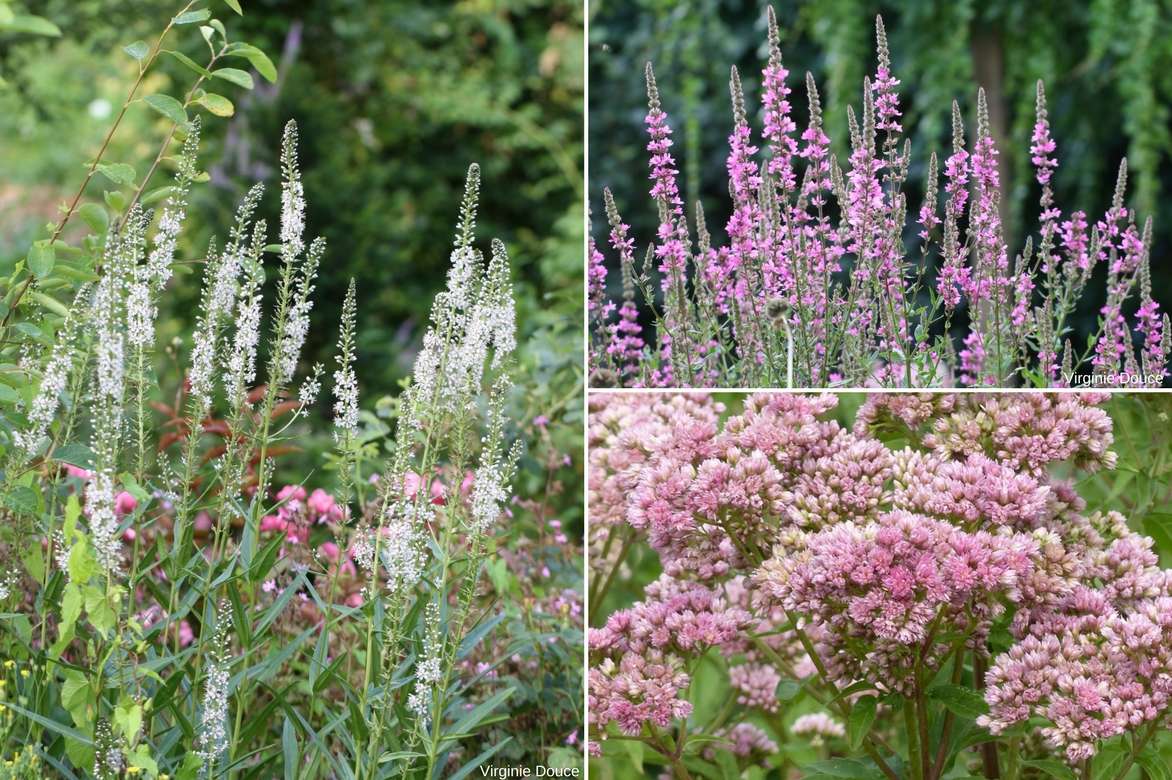

An example of a damp-soil planting combination: Lysimachia ephemerum, Lythrum salicaria, Eupatorium cannabinum ‘Plenum’.
Its rapid growth makes it a perfect plant for quickly creating a dense, verdant backdrop in borders. Pair the deep purple stems and flowers of Eupatorium maculatum ‘Atropurpureum’ with Echinacea purpurea ‘Magnus’. Add contrast and lightness with the soft white spikes of Veronicastrum virginicum var. album and the silky tufts of Stipa tenuifolia. To perfect this rustic look and add even more depth, tuck in a few plants of Verbena bonariensis with its airy mauve panicles.

A lovely mixed-border planting idea: Sedum ‘Autumn Joy’ (syn. ‘Herbstfreude’), Echinacea purpurea, Eupatorium maculata ‘Atropurpureum’, Perovskia ‘Blue Spire’.
The exquisite foliage colour of Eupatorium rugosum ‘Chocolate’ is also an excellent way to highlight plants with lighter foliage, such as the lime-green leaves of a hosta. It will also contrast elegantly with white blooms. Opt for tall flowers, like the graceful spikes of Cimicifuga.
Eupatorium coelestinum works wonders in a pastel-coloured border, paired with dahlias, petunias, or asters, which also appreciate moist soil.
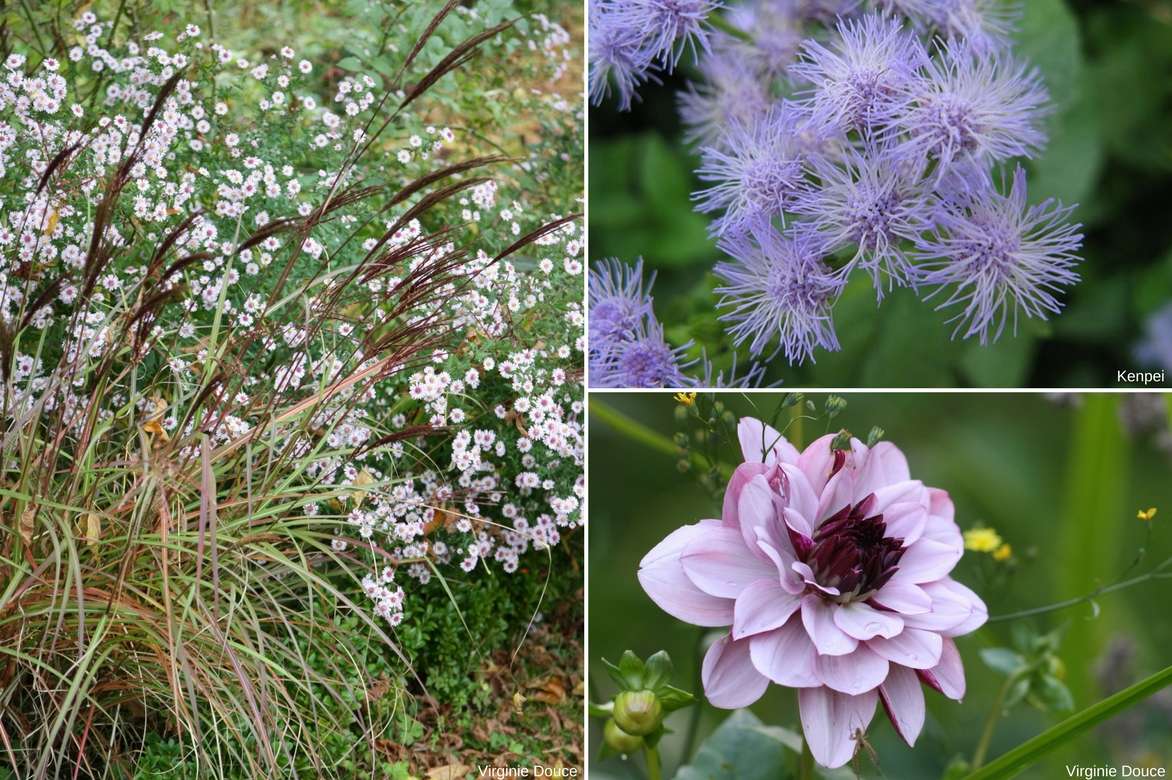
A planting combination example: Miscanthus sinensis ‘Red Chief’, Aster ‘Pink Buttons’, Eupatorium coelestinum, Dahlia ‘Crème de Cassis’.
Finally, planting it as a standalone specimen will create a beautiful focal point in your garden. Choose among the tallest varieties, which can reach up to 2m (E. cannabinum or maculatum).
Did you know?
Eupatorium is one of the emblematic plants in Piet Oudolf’s garden, the famous landscape designer of the “Dutch Wave”. His naturalistic gardens are composed of numerous varieties of perennials and grasses, selected with unparalleled artistry to create an ever-evolving “prairie garden” scene.
In Hummelo, among the many varieties cultivated in this naturalistic paradise, the Eupatorium maculatum ‘Riesenschirm’ reaches its full height (2m) and offers a most exquisite display with its large, deep purple-pink inflorescences.
Historical anecdote
The eupatory owes its name to Mithridates VI Eupator, a king who ruled long ago in Persia, around 110 BC. The monarch, fearing poisoning and convinced of the immunity provided by his antidote, allegedly regularly consumed a preparation made from hemp agrimony (Eupatorium cannabinum). However, there is no proof that the plant in question wasn’t confused with agrimony, which bears strong formal similarities, along with numerous medicinal properties.
Useful resources
Discover our wide range of bonesets!
Explore our ideas for pairing bonesets in the garden.
Take a tour of Piet Oudolf’s garden in Hummelo.
Also discover Argentinian vervain and its delicate, airy blooms.
Frequently asked questions
-
My Joe-Pye weed is struggling to regrow this spring, what should I do? (Note: "Eupatoire" is commonly known as "Joe-Pye weed" in British English, a popular ornamental plant. The translation maintains the gardening context while adapting to UK terminology.)
The growth of Joe-Pye weed can suffer from soil that is too dry or poor in nutrients. Add well-rotted compost and water very regularly to prevent the soil from drying out. Also, beware of slugs, which feast on the tender young shoots.
-
I live in the mountains where frosts are frequent in winter, is eupatorium a good choice?
Eupatorium shows excellent hardiness and establishes easily in all regions. If you're concerned about prolonged severe frosts, leave the aerial parts in place during winter as they will protect the crown. Applying winter mulch is possible, but take care that it doesn't become waterlogged.
- Subscribe!
- Contents


































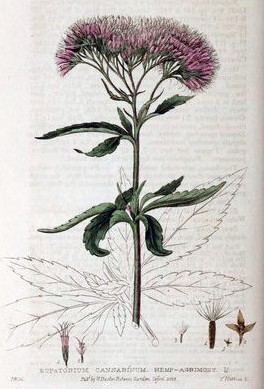
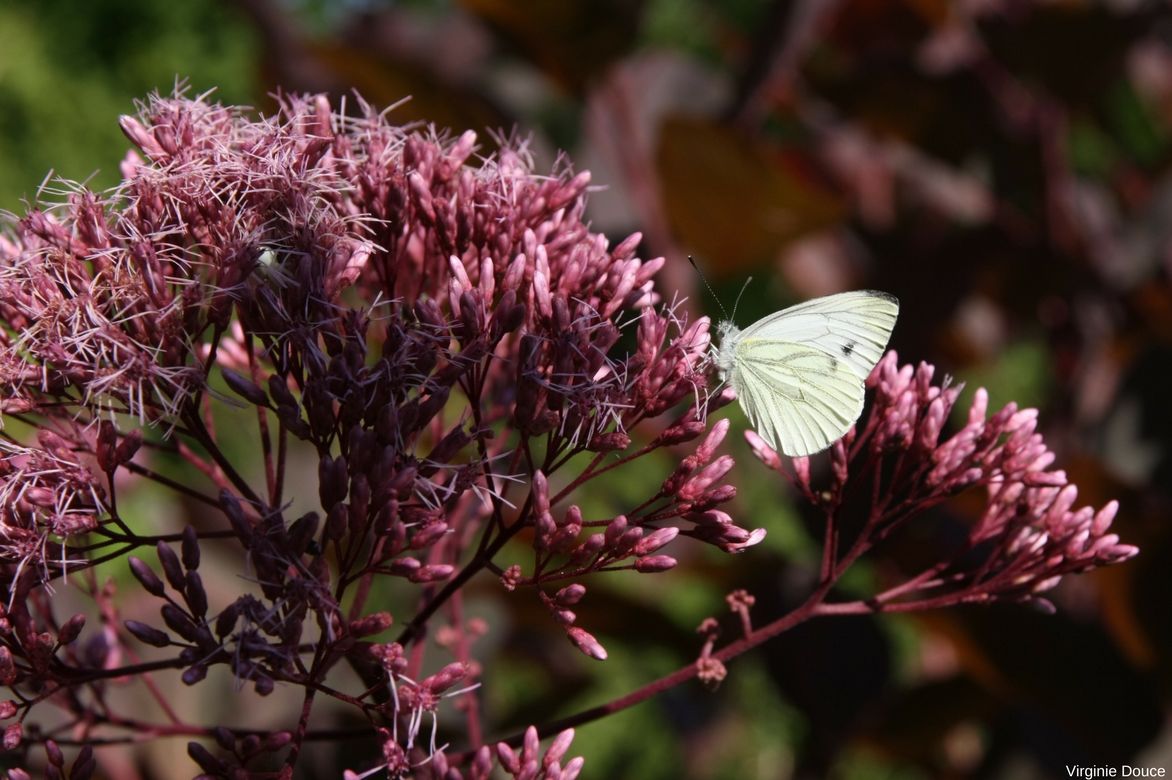

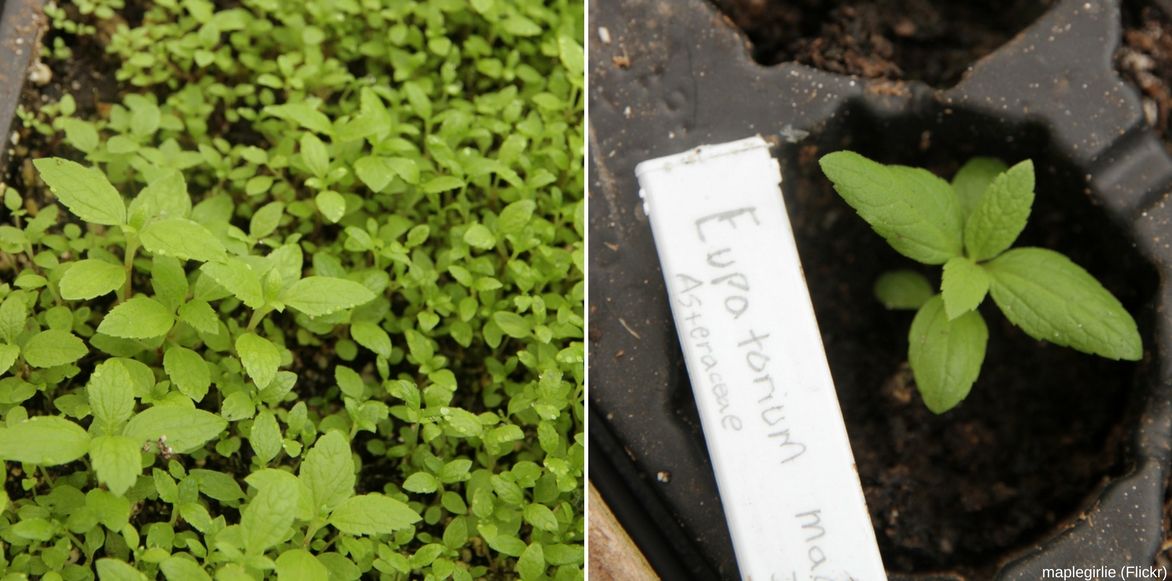
Comments